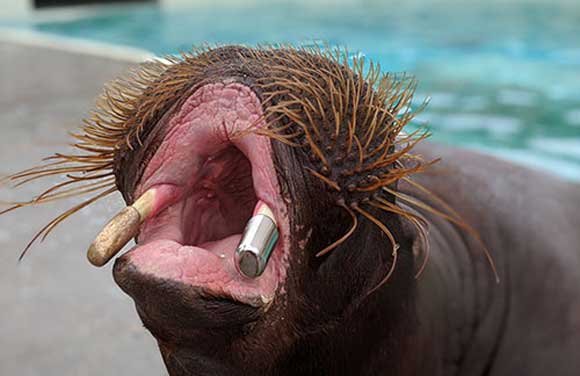Metal Additive Manufacturing used to produce crown for walrus tusk
November 2, 2020

A collaboration between the École de technologie supérieure (ÉTS), the Université de Montréal and the Aquarium du Québec, Canada, has enabled a walrus residing at the Aquarium du Québec to receive a metal additively manufactured protective crown on her tusk. The four-year-old walrus, weighing over 400 kg, was able to have the protective crown fitted in less than five minutes, without the need for anaesthesia.
The production of the metal AM crown was made possible by Vladimir Brailovski, a research professor in mechanical engineering at ÉTS; Dr Claire Grosset, a professor of zoological medicine at Université de Montréal and a veterinarian at the Aquarium du Québec; and Dr Yvan Dumais, a clinician and teacher in veterinary dentistry at Université de Montréal.
Because walruses are a species of conservation concern in Canada, four of them are housed at the Aquarium de Québec. However, in the aquarium setting, instead of walking on the ice, soil or pebbles of its natural habit, the walrus must walk on the concrete or metal of its enclosure; and, as indicated by its Latin name, Odobenus rosmarus, which translates as the animal that ‘walks on its teeth’, a walrus uses its tusks to support its weight, especially in the process of hoisting itself out of the water and onto land.
It is crucial that any damage that could be done to the walrus’s tusks by this practice is prevented, as such injuries could lead to painful and potentially dangerous dental abscesses. Dr Grosset stated, “While this practice poses no problem in a natural environment made of ice and soil, things are different in a habitat comprised of concrete, metal and other materials selected to withstand these animals, whose weight can reach more than a tonne.”
In order to prevent fracturing and cracking of the mammals’ tusks, veterinary medical experts recommend protecting the tusks with made-to-measure metal crowns, or caps. The technique is said to help avoid the need to remove the tusks in an invasive dental procedure.
Since the metal with which crowns are manufactured varies from one institution to another, the research team had to determine the metal best suited to Additive Manufacturing. The metal also had to offer maximum resistance to repetitive rubbing and compression, and not oxidise in saltwater. “We finally opted for cobalt chrome, a biocompatible alloy that is both hard and resistant to abrasion,” commented Professor Brailovski.
To ensure a perfect fit between crown and tusk, Professor Brailovski and his students Anatolie Timercan and Morgan Letenneur created three crowns, each of which offered a clearance of 0.25 to 0.45 mm between the tusk and the crown. The veterinarian was thus able to choose the one that best suited the walrus: too wide a gap between the tusk and crown would weaken the bonding of the glue, while too narrow a gap would keep the crown from fitting snugly against the tusk’s surface.
This approach is said to have offset any errors that could have accumulated in the different stages of the process, from taking the tuskprint (a dental impression of the tusk) to its digitisation and modelling using a 3D laser scanner, and finally the installation of the crown.
In addition to manufacturing the crown, a solution had to be found for installing the crown onto the walrus tusk without the use of anaesthesia, as the mortality rate under anaesthesia is particularly high for this species. Thus, over a period of several months, the walrus underwent training three or four times to increase her ability to remain immobile. The trainer rewarded these periods of immobility until the walrus was able to stay still for five minutes, allowing the installation of the metal additively manufactured crown.
















